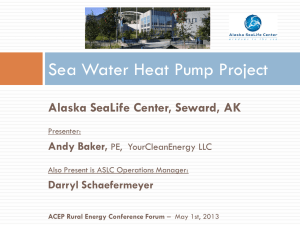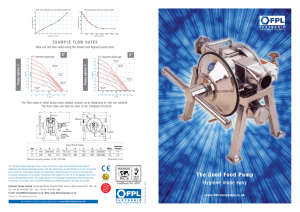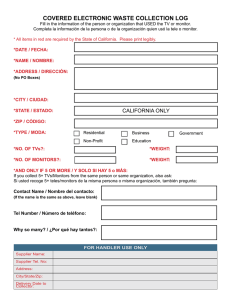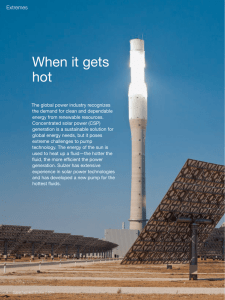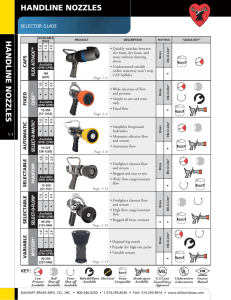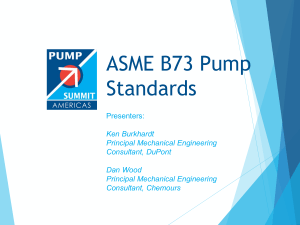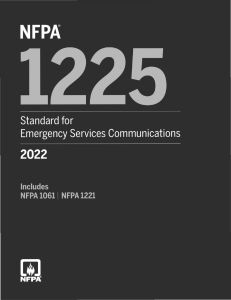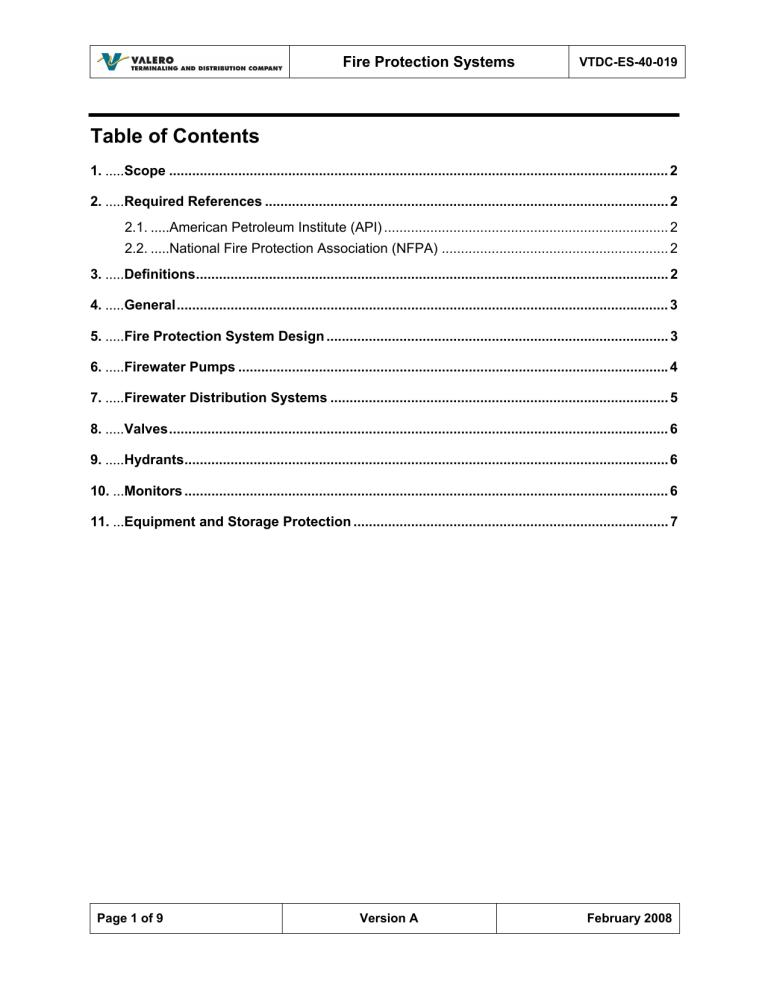
Fire Protection Systems VTDC-ES-40-019 Table of Contents 1. .....Scope .................................................................................................................................. 2 2. .....Required References ......................................................................................................... 2 2.1. .....American Petroleum Institute (API) .......................................................................... 2 2.2. .....National Fire Protection Association (NFPA) ........................................................... 2 3. .....Definitions........................................................................................................................... 2 4. .....General ................................................................................................................................ 3 5. .....Fire Protection System Design ......................................................................................... 3 6. .....Firewater Pumps ................................................................................................................ 4 7. .....Firewater Distribution Systems ........................................................................................ 5 8. .....Valves .................................................................................................................................. 6 9. .....Hydrants.............................................................................................................................. 6 10. ...Monitors .............................................................................................................................. 6 11. ...Equipment and Storage Protection .................................................................................. 7 Page 1 of 9 Version A February 2008 Fire Protection Systems VTDC-ES-40-019 1. Scope These specifications outline design and construction criteria for fire protection systems furnished to Valero Terminaling and Distribution Company (Valero) for installation at pipeline stations and terminals. 2. Required References 2.1. 2.2. American Petroleum Institute (API) API 2510 Design and Construction of LPG Installations API 2510A Fire Protection Considerations for the Design and Operation of LPG Storage Facilities National Fire Protection Association (NFPA) NFPA 11 Standard for Low-, Medium-, and High-Expansion Foam NFPA 13 Standard for the Installation of Sprinkler Systems NFPA 15 Standard for Water Spray Fixed Systems for Fire Protection NFPA 16 Standard for the Installation of Foam-Water Sprinkler and Foam-Water Spray Systems NFPA 20 Standard for the Installation of Stationary Pumps for Fire Protection NFPA 24 Standard for the Installation of Private Fire Service Mains and Their Appurtenances NFPA 30 Flammable and Combustible Liquids Code NFPA 58 Liquefied Petroleum Gas Code NFPA FPH 10-3 Fire Protection Handbook: Water Distribution Systems NFPA FPH 11-5 Fire Protection Handbook: Foam Extinguishing Agents and Systems 3. Definitions Acceptable Monitor Coverage - Fire monitors should be located to adequately protect equipment from two different directions with a clear line-of-sight between the monitor and the protected equipment. They are ideally located 50 to 100 feet from the protected equipment. Monitors located less that 50 feet from the protected equipment might be inaccessible during a fire due to radiant heat exposure. Monitors in excess of 100 feet from the protected equipment will not be effective in unfavorable wind conditions or when variable spray patterns are needed. Fire Potential Equipment - Fire potential equipment is defined as equipment that may release a significant amount of flammable or combustible liquids or LPG. Piping is not considered fire Page 2 of 9 Version A February 2008 Fire Protection Systems VTDC-ES-40-019 potential equipment for the purpose of this specification. Fire potential equipment includes the following: - Fired heaters (asphalt terminals) - Pumps with motors or engines handling flammable liquids, combustible liquids, or LPG - Vapor combustors - Tankage - Sample houses 4. General Firewater design capacity shall be that needed to control the largest fire risk at the subject facility. Pumping capacity shall be adequate to provide the demand under the most adverse operating conditions. Firewater storage capacity shall be capable of providing 100% of the required pumping capacity for at least six hours. Water sources are preferably natural or manmade surface water bodies. When this is not possible, the supply shall be from storage tank(s). When municipal water or well water is the only available source of firewater, storage tank supply lines shall be sized to refill the tank by providing at least one half of the largest firewater demand on a continuous basis if possible. Available drainage must be reviewed during the design to ensure the hazards of floating pool fires, sewer backups, electrical equipment, and other safety concerns have been properly addressed as part of the system design. All fire protection equipment (hydrants, monitors, block valves, etc.) shall be consistent with other existing plant fire protection equipment and shall be approved by Valero’s heath and safety representative. Valero’s health and safety representative shall approve working plans/drawings prior to all firewater equipment installations and modifications. All firewater pumping and distribution projects may require review and approval by Valero’s health and safety representative and any governmental authorities having jurisdiction. 5. Fire Protection System Design If possible, an electric pump with an engine-driven pump backup shall be used to furnish the total facility firewater pumping capacity at the required pressure. The number and size of pumps shall be such that failure of a single fire pump does not decrease the total pumping capacity to below the highest fire demand. Where firewater systems are required for terminals, the minimum firewater pumping capacity will be based on the requirements to extinguish the largest single tank plus 1,500 GPM for cooling and supplemental water streams. Redundant pumping supplies are not required for terminals. The minimum firewater design rate shall be 4,000 GPM at 100 psi residual pressure. Residual pressure shall be calculated using the hydrant that is the most hydraulically remote from the pumping Page 3 of 9 Version A February 2008 Fire Protection Systems VTDC-ES-40-019 source. Firewater supplies for fixed deluge and sprinkler systems are in addition to the base 4,000 GPM requirement. Pumping capacities needed to support deluge or sprinkler systems on pressurized or refrigerated LPG storage units are in addition to the base pumping capacity required to extinguish the largest tank. NOTE: The firewater demand for cooling pressurized spheres or bullets may exceed the atmospheric storage tank fire water demand when spheres are of large diameter, or when a number of spheres or bullets are closely spaced. Simultaneous application of cooling water is required for all adjacent spheres and bullets when the shell to shell separation distance is less than 100 feet. 6. Firewater Pumps All firewater pumps, pump drivers, pump controllers, and associated equipment must be designed and installed in accordance with NFPA 20, the requirements of the governing municipality, as well as the guidelines provided in this standard. The Valero health and safety representative must approve any deviations from the standard. All fire pumps, pump drivers, pump controllers, and associated equipment must be UL listed and/or FM approved for fire pump service. A complete plan and detailed data describing the pump, driver, controller, power supply, fittings, suction and discharge connections, and water supply conditions shall be prepared for approval by the Valero health and safety representative and governing municipality. Valero insurance carriers provide no credit for steam driven pumps and they should not be considered for new installations or used in the hydraulic design calculations for new fire protection systems. The use of diesel engine-driven fire pumps is preferred. Electric motor driven pumps are acceptable as long as they are used in conjunction with diesel pumps to prevent a total loss of fire protection during a power outage. The number and size of electric motor driven pumps shall be such that a power failure would not decrease the total pumping capacity to below the highest fire demand. NOTE: Pressure maintenance (jockey) pumps may be electric motor driven. The pump design shall be hydraulically balanced at all speeds and pressures. The thrust bearings shall be designed to withstand an imbalance condition from either direction. As a minimum, renewable case wear rings shall be provided. Suction piping for horizontal split-case pumps must extend at least 10 pipe diameters beyond the fire pump suction flange before the first elbow or tee may be installed. Butterfly valves shall not be used in suction piping. A butterfly valve can create turbulence that adversely affects pump performance. Water quality should be evaluated (hardness, corrosivity, sludge content) when determining the type of engine cooling system provided. Heat exchangers are prone to plugging and failure and may prove to be unreliable under poor water quality conditions. If necessary, closed radiator systems should be utilized. Fuel tanks for diesel engine drivers shall have a capacity sized to provide six hours of continuous service at 100% of rated pump speed. Page 4 of 9 Version A February 2008 Fire Protection Systems VTDC-ES-40-019 Metering devices or a test header shall be provided for testing. Metering devices must be UL listed and/or FM approved and capable of flowing 175% of pump capacity. Test headers must provide the appropriate number of test outlets as specified in NFPA 20. Where meter system piping exceeds 100 feet (straight pipe length plus equivalent length of fittings) the next larger size of piping shall be used to minimize friction loss. Controllers shall be UL listed and/or FM approved for the specific type of drive to which it is connected. Controllers shall be located as close as practical to the engine or motor that it controls. For all pump installations (including jockey pumps), each controller shall have its own pressure sensing line. All fire pumps shall be arranged to start automatically upon drop in pressure. Sequential starting shall be arranged in a manner that prevents any one engine from starting simultaneously with any other engine. Field acceptance tests outlined in NFPA 20 are required upon completion of the installation. Corporate health and safety representative, as well as applicable insurance providers, shall be invited to witness acceptance tests. 7. Firewater Distribution Systems The installation of firewater distribution systems and related equipment shall follow the guidelines of NFPA 24 as well as the guidelines provided in this standard. Connections for permanent use of firewater other than for fire protection are strongly discouraged and require the approval of the Valero heath and safety representative. Total non fire-related water usage can not exceed the capacity of the pressure maintenance (jockey) pump. Dead end mains should be avoided whenever feasible by arranging for the mains to be looped around process and tank farm areas to obtain a more reliable supply and improve hydraulic performance. All pipe must be UL listed and/or FM approved for fire service or ensure it complies with the appropriate American Water Works Association (AWWA) publication as per NFPA 24. Pipe sizing and classification shall be determined by hydraulic calculation based on the largest calculated demand, appropriate pressure, and hydraulic gradient. In general, piping will be 12-inch diameter and larger where demands are 2000 gpm and higher. NOTE: Consideration should be given to increasing from calculated pipe sizes whenever feasible. The cost to use pipe that is one or more pipe sizes larger is relatively incidental when compared to the total costs associated with installing underground pipe. Increasing the pipe diameter only one size will often nearly double the possible flow and allow for future additions to the system. Underground carbon steel piping shall be protected from external corrosion using a suitable protective coating system. Concrete lined pipe is not required unless specified by local code or warranted by water conditions. PVC pipe and fittings are preferred in terminals. Repair and impairment history has shown that fiberglass-reinforced plastic (FRP), High density polyethylene (HDPE), and other plastic pipes are not desirable piping alternatives. While friction loss characteristics make the use of plastic pipe desirable in some circumstances, reliability issues will typically prove a more significant factor in the overall evaluation. Any use of plastic pipe requires evaluation and approval by Valero’s health and safety representative. Page 5 of 9 Version A February 2008 Fire Protection Systems VTDC-ES-40-019 All tees, bends, reducers, valves, and branches shall be appropriately restrained against movement. 8. Valves All valves controlling firewater supplies shall be UL listed and/or FM approved for fire service installations. Indicating valves are preferred to non-indicating valves whenever possible. Nonindicating valves must be approved and selected by Valero’s health and safety representative. Sectional control valve location and arrangement shall be provided so that impairments do not isolate a significant number of plant protection systems. A maximum of five service devices (hydrants, monitors, sprinkler system headers, etc) or 1000 feet of underground fire main are allowed between section control valves. The Valero health and safety representative can provide variance to sectional control valve requirements. 9. Hydrants Hydrants shall be approved for fire service. The supply connection shall not be less than a 6-inch connection to the associated fire main. Hydrants shall be capable of providing a nominal 1,000 GPM at 80 psi. Maximum hydrant spacing shall be 300 feet. Hydrant spacing varies based on the fire hazard and layout of the area, as well as several other factors. Valero’s health and safety representative may specify alternative spacing. Tank farms hydrant spacing shall ensure that a sufficient number of hydrants are provided to supply the design firewater capacity for the tank(s). Hydrants shall not be located within the diked area. The Valero heath and safety representative shall determine the number of 2½-inch connections and pumper connection size(s) for all new hydrants. Hydrant outlet threads shall match the local fire hose thread standard or an alternative thread standard specified by the Valero heath and safety representative. Self-draining hydrants shall be used in freezing climates. Consider large volume headers in lieu of hydrants in high demand areas such as tank farms and large process areas. Consult the Valero heath and safety representative for additional guidance and construction details. 10. Monitors Fire monitors are located to adequately protect equipment from two different directions with a clear line-of-sight between the monitor and the protected equipment. They are ideally located 50 to 100 feet from the protected equipment. Monitors located less that 50 feet from the protected equipment might be inaccessible during a fire due to radiant heat exposure. Monitors in excess of 100 feet from the protected equipment will not be effective in unfavorable wind conditions or when variable spray patterns are needed. Page 6 of 9 Version A February 2008 Fire Protection Systems VTDC-ES-40-019 Monitor coverage shall extend to the complete unit area and any other major hydrocarbon containing equipment. All monitors shall be capable of delivering at least 500 GPM with an effective nozzle range of 100 feet at 80 psi discharge pressure. Combination straight stream/fog nozzles are generally preferred in operating areas so that full fog coverage can be provided to protect the monitor operator. Monitor nozzle applications vary according to size and type of nozzle (smooth bore, adjustable fog, foam type, etc.) as well as protection and coverage requirements. When combination nozzles are not the appropriate protection measure, the Valero heath and safety representative shall be consulted to ensure proper nozzle selection. Monitors may be elevated to ensure adequate protection. 11. Equipment and Storage Protection Acceptable monitor coverage must be provided for all fire potential equipment within the facility. Cooling by water spray impinging on and flowing over the protected surfaces shall also be provided for the following types of equipment and storage vessels: non-insulated vessels vessel skirts with no fireproofing vessels containing Class I flammable liquids or liquefied gases instrument trays/conduit runs Vessels, supporting structures and instrument trays do not require water spray protection when provided with adequate fireproofing or in remote areas. All fixed water spray application systems shall be designed, installed, and tested in accordance with NFPA 15. All foam and foam/water application systems shall be designed, installed, and tested in accordance with NFPA 11 and NFPA 16, whichever is applicable. Deluge foam-water systems may be necessary where a flammable or combustible liquid pool fire is expected. This is particularly true in areas with poor drainage. Foam systems should be designed for a minimum 20-minute supply and designed in accordance with NFPA 16. Fire Potential Equipment that cannot be protected with acceptable monitor coverage must be protected according to the guidelines below: Pumps - All pumps handling flammable or combustible liquids or LPG must have fixed deluge protection providing at least two spray nozzles directed at the pump seal area. Provide an application rate of 0.50 gpm/ft2 for the pump casing and a surrounding 2-foot distance. EXCEPTION: Pumps that do not expose other equipment or structures and pumps without shaft seals, such as can pumps, do not require water spray protection. LPG Spheres –Spheres shall be provided with a top mounted firewater deluge system to cover the upper hemisphere and designed to provide 0.25 gpm/ft2 to one-half of the total sphere surface area. In determining firewater application rates, the surface area of the vessel that could be exposed to fire shall be the surface area of the vessel above the level of the liquid contents at the vessels lowest operating level. Water weirs may be used in lieu of spray nozzles. Fixed firewater monitors shall be provided on at least two sides of each sphere so that they can reach the entire underside of the vessel. Page 7 of 9 Version A February 2008 Fire Protection Systems VTDC-ES-40-019 LPG Bullet tanks – Tanks containing greater than 10,000 pounds of LPG shall be provided with acceptable monitor coverage and fixed deluge protection designed to provide an application rate of 0.25 gpm/ft2 over the surface of the vessel. Truck Loading Racks - Foam/water sprinklers shall be used for protection of tank truck loading racks and designed to provide 0.25 gpm/ft2 for the area under the loading rack canopy. External floating roof tanks – Provide foam application with requirements based on a seal fire scenario. If using a fixed application (such as foam chambers or subsurface injection), the design shall be based on 0.30 GPM/Ft2 of annular ring area. If the response plan calls for mobile application (i.e. using large tank monitors or fire trucks to “go over the top”), the foam application rate should be based on 0.16 GPM/Ft2 of total surface area. Floating roof tanks with diameters over 150 feet must include mobile application in the overall calculations with a mobile equipment foam application rate of 0.20 gpm/ft2. Consult the foam system manufacturer and the Valero heath and safety representative for additional details regarding design application rates. Internal Floating Roof and Cone Roof Tanks – Provide foam application with requirements based on fully involved tank fire. If using a fixed application (such as foam chambers or subsurface injection), the design shall be based on 0.10 GPM/Ft2 of foam application. If the response plan calls for mobile application (i.e. using large tank monitors or fire trucks to “go over the top”), the foam application rate should be increased to 0.20 GPM/Ft2. Tanks with diameters over 150 feet should increase the foam application rate to 0.20 gpm/ft2 and must include mobile application in the overall calculations. Consult the foam system manufacturer and the Valero heath and safety representative for additional details regarding design application rates. Page 8 of 9 Version A February 2008 Fire Protection Systems VTDC-ES-40-019 Revision Record Version Remarks A Original Page 9 of 9 Initiator Approval Date Final June 2005 Version A February 2008
